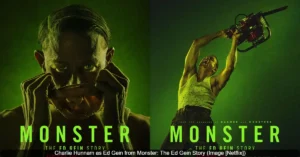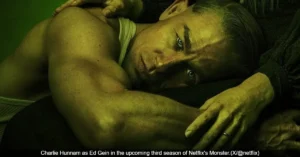Netflix’s Monster: The Ed Gein Story has captivated audiences with its chilling portrayal of one of America’s most infamous killers. The series, starring Charlie Hunnam, blends fact with creative fiction, leaving many viewers to wonder what events actually happened and which were invented for television. While the show is based on the real-life story of Ed Gein, also known as the “Butcher of Plainfield,” several major plot points take significant creative liberties with the historical record.
The Fictional Romance with Bernice Worden
One of the most surprising storylines in the series depicts a romantic and sexual relationship between Ed Gein and his victim, Bernice Worden, the hardware store owner he confessed to killing in 1957. Their on-screen affair is portrayed as intimate and ongoing before her murder.
In reality, there is no evidence to support this relationship. After his arrest, Gein told doctors at Central State Hospital that he had never had a sexual experience in his life. The real clue that led investigators to Gein for Worden’s murder was not a romantic gift tag, as shown in the series, but a sales receipt for antifreeze that was the last item Worden sold before her disappearance.
The Mysterious Death of Henry Gein
The series begins with a dramatic depiction of Ed Gein killing his older brother, Henry. After Henry reveals plans to leave their domineering mother, Ed strikes him with a block of wood and stages a brush fire to cover up the murder.
The truth about Henry Gein’s death remains uncertain. In real life, Henry died in May 1944 while he and Ed were fighting a marsh fire on their property. The official cause of death was ruled as asphyxiation leading to heart failure, and authorities at the time considered it an accident. While some later investigators grew suspicious after Ed’s other crimes were discovered, no evidence ever proved foul play, and Ed never confessed to killing his brother.
The Chainsaw Murder of Two Hunters
In a particularly gruesome scene, the show depicts Gein brutally killing two lost bear hunters, Victor Travis and Raymond Burgess, with a chainsaw after they stumble upon him mutilating a victim.
This event is complete fiction. There is no evidence connecting Gein to the disappearances of Travis and Burgess, whose fate remains unsolved. The chainsaw murder does not fit Gein’s known pattern of crimes, as he used guns and knives on his confirmed victims. This storyline appears to be an invention designed to create a connection to The Texas Chainsaw Massacre, one of the many horror films Gein later inspired.
The Babysitter Murder
The series shows Gein stalking, abducting, and murdering a babysitter named Evelyn Hartley in retaliation for her “taking” his babysitting job.
While Evelyn Hartley was a real person who disappeared in 1954, Gein was not responsible for her abduction. He was questioned about her case because he had been visiting La Crosse County around the time she vanished, but he denied any involvement. After passing two lie detector tests, he was officially cleared in her case, which remains unsolved.
Adeline Watkins: Girlfriend and Accomplice
Netflix’s series creates a central character in Adeline Watkins, portrayed as Gein’s longtime girlfriend and willing accomplice who encourages his violent tendencies and even joins him in grave robbing.
The real Adeline Watkins existed, but their relationship was far less dramatic. Initially after Gein’s arrest, Watkins told newspapers they had a 20-year relationship and that Gein had proposed. However, she quickly retracted these claims, stating their romance lasted less than a year and that they had only attended a few shows together at the Plainfield Theater. She clarified they were merely friends and that earlier reports were “exaggerated and blown up out of proportion.”
Necrophilia and Cannibalism
The show includes multiple scenes depicting Gein engaging in sexual acts with corpses and suggesting he practiced cannibalism, including distributing human flesh to neighbors as venison.
Gein repeatedly denied being a necrophiliac, telling doctors the smell of the corpses was a deterrent. There is also no evidence he was a cannibal. Most of the bodies he exhumed had been embalmed, making consumption highly unlikely.
The Hospital Murder
In one episode, Gein is shown killing a nurse at the mental hospital where he was confined after his arrest. The scene is later revealed to be part of a schizophrenic episode.
This event never occurred. In reality, Gein was reported as a model patient during his confinement at Central State Hospital and later at the Mendota Mental Health Institute, where he died in 1984 from complications of lung cancer.
Helping the FBI Catch Ted Bundy
The final episode takes a significant fictional turn by showing Gein helping FBI agents from the Behavioral Science Unit profile and capture serial killer Ted Bundy.
There is no evidence that Gein ever assisted the FBI with any active investigations. He was never interviewed by the Bureau and played no role in Bundy’s real-life capture in 1978. The series frames this scenario as potentially one of Gein’s schizophrenic hallucinations.
What the Series Got Right
Despite these fictionalized elements, the series accurately portrays several key aspects of Gein’s life and crimes. His deeply troubled relationship with his domineering, fanatically religious mother Augusta Gein is well-documented, as is his habit of creating a shrine to her in their home after her death. The horrific artifacts police discovered in his house—including the famous “woman suit” made of human skin, masks made from facial skin, chairs upholstered in human skin, and a box containing nine vulvas—were all real findings.
Gein did indeed confess to robbing approximately nine graves from 1947 to 1952 and creating keepsakes from human bones and skin. He also admitted to two murders: Mary Hogan in 1954 and Bernice Worden in 1957. His fascination with Nazi war criminals, particularly Ilse Koch (the “Bitch of Buchenwald”), who was accused of making lampshades from human skin, is also based on historical accounts of his reading habits.
Gein’s enduring cultural impact is accurately represented in the series. His crimes directly inspired three classic horror films: Psycho (Norman Bates), The Texas Chain Saw Massacre (Leatherface), and The Silence of the Lambs (Buffalo Bill). The series effectively shows how Gein’s case influenced both popular culture and the early development of FBI criminal profiling.
The real Ed Gein was found legally insane and spent the remainder of his life in psychiatric institutions rather than prison. He was initially declared unfit for trial in 1957, diagnosed with schizophrenia. When he was finally tried in 1968 for the murder of Bernice Worden, he was found guilty but legally insane at the time of the crime and was returned to a mental hospital until his death.









